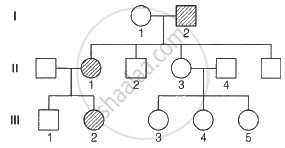Advertisements
Advertisements
Question
Answer the following question.
Both Haemophilia and Thalessemia are blood-related disorders in humans. Write their causes and the difference between the two. Name the category of genetic disorder they both come under.
Solution
Both are Mendelian disorders.
- Haemophilia is a sex-linked recessive disorder. The gene for haemophilia is located on X-chromosome. The gene passes from a carrier female to her son.
- Thalessemia is an autosomal linked recessive disease.
- It occurs due to either mutation or deletion resulting in reduced rate of synthesis of one of the globin chains of haemoglobin
- The difference between Haemophilia and Thalessemia is: -In haemophilia, clotting is affected, i.e. there can be a non-stop bleeding even after a minor cut.
- In Thalessemia, anaemia is the characteristic of this disease.
APPEARS IN
RELATED QUESTIONS
Give any 'two' names of X-linked diseases
What will be the phenotype of progeny, if a carrier haemophilic female marries a normal male?
About 8% of the human male population suffers from colour blindness, whereas only about 0.4% of the human female population suffers from this disease. Write an explanation to show how it is possible.
Name a disorder a human suffers from as a result of the monosomy of the sex chromosome. Give the karyotype and write the symptoms.
Mention the symptoms of Phenylketonuria.
Read the following statements and select the correct option.
i. Genetic disorders are broadly categorised as, Mendelian disorders and chromosomal disorders.
ii. Mendelian disorders are caused due to absence or excess of one or more chromosomes or their abnormal arrangement.
iii. Chromosomal disorders are mainly caused due to alteration or mutation in the gene.
Feminised males have ______ chromosomes.
A woman with albinic father marries an albinic man. The proportion of her progeny is ______.
Where are the genes for cytoplasmic male sterility in plants located?
Fused ear lobes appear in the progeny due to an autosomal recessive gene. Work out the genotypes of number in the given pedigree.

